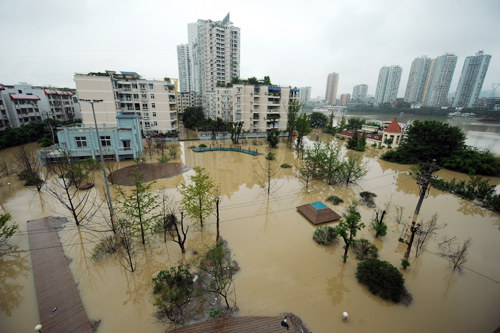|
 |
|
INUNDATED: Houses submerged by flooding in Hechuan District, southwest China's Chongqing Municipality, on September 20. Rain-triggered floods since September 1 affected 6.18 million in Chongqing and Sichuan, Shaanxi, Henan, Hubei, Shandong, Shanxi, Gansu and Qinghai provinces, leaving at least 90 people dead and 22 others missing by September 21 (ZHOU HENGYI) |
The Chinese Government on September 21 expressed strong indignation and resolute opposition over a new round of U.S. arms sales to Taiwan.
"The wrongdoing by the U.S. side will inevitably undermine bilateral relations as well as exchanges and cooperation in military and security areas," said Vice Foreign Minister Zhang Zhijun, who was instructed to summon U.S. Ambassador to China Gary Locke in Beijing.
Regardless of China's repeated solemn representations, the U.S. administration announced a new arms package worth $5.852 billion to Taiwan, including the so-called "upgrading" of F-16A/B fighter jets.
"The Taiwan issue concerns China's sovereignty and territorial integrity, impacts China's core interests and touches the national feeling of 1.3 billion Chinese," the vice foreign minister said. "It is always the most important and most sensitive core issue in China-U.S. relations."
Zhang Yesui, Chinese Ambassador to the United States, also lodged strong protests on behalf of the Chinese Government in Washington, D.C.
The yield from a hybrid variety of rice bred in China has exceeded 900 kg per mu (0.067 hectare), setting a new world record in the productivity of rice.
The rice strain, DH2525, produced a harvest of 926.6 kg per mu during its trial plantation in Longhui County in Hunan Province, said the provincial academy of agriculture at a press conference on September 19.
To ensure the accuracy of the yield measurement, an expert panel under the Ministry of Agriculture (MOA) randomly selected three out of the 107.9 mu trial field's 18 plots and supervised the harvest on September 18.
DH2525 was developed by Yuan Longping, known as the "father of hybrid rice," who started developing hybrid rice in the 1960s. His research team achieved target yields of 700 kg per mu and 800 kg per mu in 1999 and 2005, respectively, setting world records on both occasions.
However, the new variety will not be deemed a total success until it produces a 900 kg yield per mu yield on at least 100 mu of farmland for two consecutive years, according to the MOA expert panel.
The Supreme People's Procuratorate (SPP) of China unveiled on September 18 plans to set up a national online database of individuals convicted bribers by the end of this year.
The database will serve as an admittance control mechanism in bidding and government procurement procedures, the SPP said in a statement.
China has posted online lists of the names of bribers since 2006, but the new list will be more detailed and comprehensive. These lists have effectively deterred some cases of corruption as well as commercial bribery, said the SPP.
Statistics released by the Ministry of Public Security show the number of automobiles in China has surged to 100 million.
China registered 219 million motor vehicles as of the end of August, with automobiles accounting for 45.88 percent. The ministry separates motor vehicles into four categories: motorcycles, tractors, trucks and automobiles.
From 2006 to 2010, China posted an average annual growth of 9.51 million automobiles.
In the first eight months of this year, 9.83 million new automobiles hit the road in China, 79.45 percent of which were passenger cars. | 